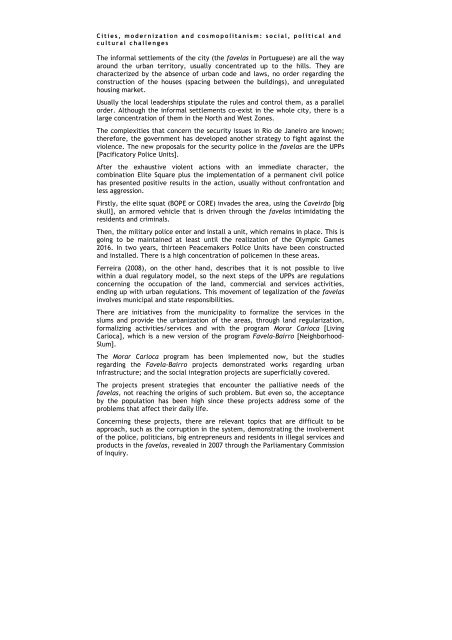MEGA-EVENTS IN RIO DE JANEIRO AND THEIR ... - FAU
MEGA-EVENTS IN RIO DE JANEIRO AND THEIR ... - FAU
MEGA-EVENTS IN RIO DE JANEIRO AND THEIR ... - FAU
Create successful ePaper yourself
Turn your PDF publications into a flip-book with our unique Google optimized e-Paper software.
C i t i e s , m o d e r n i z a t i o n a n d c o s m o p o l i t a n i s m : s o c i a l , p o l i t i c a l a n d<br />
c u l t u r a l c h a l l e n g e s<br />
The informal settlements of the city (the favelas in Portuguese) are all the way<br />
around the urban territory, usually concentrated up to the hills. They are<br />
characterized by the absence of urban code and laws, no order regarding the<br />
construction of the houses (spacing between the buildings), and unregulated<br />
housing market.<br />
Usually the local leaderships stipulate the rules and control them, as a parallel<br />
order. Although the informal settlements co-exist in the whole city, there is a<br />
large concentration of them in the North and West Zones.<br />
The complexities that concern the security issues in Rio de Janeiro are known;<br />
therefore, the government has developed another strategy to fight against the<br />
violence. The new proposals for the security police in the favelas are the UPPs<br />
[Pacificatory Police Units].<br />
After the exhaustive violent actions with an immediate character, the<br />
combination Elite Square plus the implementation of a permanent civil police<br />
has presented positive results in the action, usually without confrontation and<br />
less aggression.<br />
Firstly, the elite squat (BOPE or CORE) invades the area, using the Caveirão [big<br />
skull], an armored vehicle that is driven through the favelas intimidating the<br />
residents and criminals.<br />
Then, the military police enter and install a unit, which remains in place. This is<br />
going to be maintained at least until the realization of the Olympic Games<br />
2016. In two years, thirteen Peacemakers Police Units have been constructed<br />
and installed. There is a high concentration of policemen in these areas.<br />
Ferreira (2008), on the other hand, describes that it is not possible to live<br />
within a dual regulatory model, so the next steps of the UPPs are regulations<br />
concerning the occupation of the land, commercial and services activities,<br />
ending up with urban regulations. This movement of legalization of the favelas<br />
involves municipal and state responsibilities.<br />
There are initiatives from the municipality to formalize the services in the<br />
slums and provide the urbanization of the areas, through land regularization,<br />
formalizing activities/services and with the program Morar Carioca [Living<br />
Carioca], which is a new version of the program Favela-Bairro [Neighborhood-<br />
Slum].<br />
The Morar Carioca program has been implemented now, but the studies<br />
regarding the Favela-Bairro projects demonstrated works regarding urban<br />
infrastructure; and the social integration projects are superficially covered.<br />
The projects present strategies that encounter the palliative needs of the<br />
favelas, not reaching the origins of such problem. But even so, the acceptance<br />
by the population has been high since these projects address some of the<br />
problems that affect their daily life.<br />
Concerning these projects, there are relevant topics that are difficult to be<br />
approach, such as the corruption in the system, demonstrating the involvement<br />
of the police, politicians, big entrepreneurs and residents in illegal services and<br />
products in the favelas, revealed in 2007 through the Parliamentary Commission<br />
of Inquiry.

















